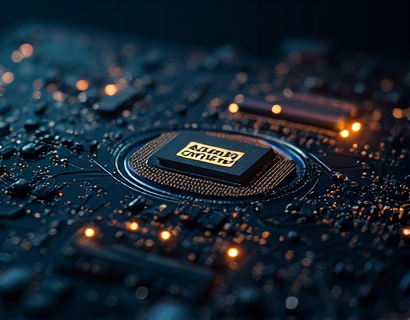Smart Contract Driven Creation of UCASH-Pegged Stablecoins for Seamless DeFi Exchange
In the rapidly evolving landscape of decentralized finance, or DeFi, the integration of smart contract technology has opened new avenues for the creation and management of digital currencies. One of the most significant advancements in this domain is the development of stablecoins pegged to UCASH, a hypothetical stablecoin, through smart contracts. This innovative approach not only ensures the stability and reliability of these digital assets but also facilitates seamless bidirectional trading, thereby enhancing the overall efficiency and flexibility of DeFi ecosystems.
The concept of stablecoins is not new; however, the traditional methods of creating and maintaining their stability have been fraught with challenges. Centralized authorities often issue stablecoins, raising concerns about trust, transparency, and censorship. Smart contract-driven stablecoins, on the other hand, offer a decentralized and trustless solution. By leveraging the immutable and transparent nature of blockchain technology, these stablecoins can be created and managed without the need for intermediaries, reducing risks and increasing accessibility.
Understanding UCASH-Pegged Stablecoins
UCASH, in this context, represents a stablecoin designed to maintain a stable value relative to a specific asset or basket of assets. The term "UCASH-pegged" indicates that the value of these stablecoins is tied to UCASH, ensuring minimal price fluctuations. This stability is crucial for DeFi applications, as it allows users to engage in trading and lending without the volatility associated with traditional cryptocurrencies.
The smart contract mechanism behind UCASH-pegged stablecoins involves a set of predefined rules and algorithms that govern the issuance, circulation, and redemption of these digital assets. These contracts are deployed on blockchain networks, such as Ethereum, which provide the necessary infrastructure for executing transactions and maintaining the integrity of the system.
Key Components of Smart Contract Driven Stablecoin Creation
The creation of UCASH-pegged stablecoins through smart contracts involves several key components that work together to ensure the stability and functionality of the system.
1. Reserve Management
One of the fundamental aspects of stablecoin creation is the management of reserves. In the case of UCASH-pegged stablecoins, the smart contract must ensure that a sufficient amount of UCASH or equivalent assets is locked away as collateral. This reserve acts as a guarantee for the stablecoin's value, providing confidence to users and participants in the DeFi ecosystem.
The smart contract automatically manages the reserve by depositing and withdrawing UCASH based on the issuance and redemption of stablecoins. When a user requests to create stablecoins, the smart contract checks if there is enough UCASH in the reserve to cover the issuance. If sufficient reserves are available, the contract mints the stablecoins and transfers the corresponding UCASH to the user's wallet. Conversely, when a user wants to redeem stablecoins for UCASH, the contract checks the stablecoin balance, deducts the stablecoins, and transfers the UCASH to the user's wallet, updating the reserve accordingly.
2. Price Stability Mechanisms
Maintaining price stability is critical for the success of UCASH-pegged stablecoins. Smart contracts incorporate various mechanisms to achieve and maintain this stability, even in the face of market volatility.
One common mechanism is the algorithmic stablecoin approach, where the smart contract adjusts the supply of stablecoins in response to market conditions. For instance, if the price of the stablecoin begins to deviate from the peg, the smart contract can automatically release or absorb stablecoins to bring the price back in line. This dynamic adjustment helps to stabilize the market and maintain user trust.
Another approach involves the use of decentralized autonomous organizations (DAOs) to manage the reserve and implement stability measures. The DAO can include a group of stakeholders who vote on proposals to adjust the smart contract parameters, such as the interest rates on stablecoin lending or the mechanisms for adding or removing reserves. This decentralized governance model enhances transparency and community involvement in the stablecoin's management.
3. Security and Auditing
Security is paramount in the realm of smart contracts and DeFi. The smart contracts governing UCASH-pegged stablecoins must be thoroughly audited to identify and mitigate potential vulnerabilities. Security audits are conducted by independent experts who review the code for bugs, exploits, and other security risks.
Additionally, the use of formal verification methods can provide mathematical proof of the contract's correctness, ensuring that it behaves as intended under all possible scenarios. These measures build trust among users and participants, encouraging broader adoption of UCASH-pegged stablecoins in DeFi applications.
Benefits of Smart Contract Driven Stablecoins
The adoption of smart contract driven UCASH-pegged stablecoins offers numerous benefits to the DeFi ecosystem and its users.
1. Decentralization and Trustlessness
By eliminating intermediaries, smart contract driven stablecoins promote a decentralized and trustless environment. Users can interact directly with the smart contracts without the need for trusted third parties, reducing the risk of censorship and fraud. This decentralized nature aligns with the core principles of blockchain technology and enhances the overall resilience of the DeFi ecosystem.
2. Enhanced Efficiency and Speed
Smart contracts execute transactions automatically and instantly, provided the necessary conditions are met. This automation significantly reduces the time and cost associated with traditional financial processes. Users can create, trade, and redeem UCASH-pegged stablecoins with minimal latency, making the DeFi experience more efficient and user-friendly.
3. Increased Accessibility
The accessibility of UCASH-pegged stablecoins is another significant advantage. Since these stablecoins are built on open-source smart contracts deployed on public blockchains, anyone with an internet connection can participate in the DeFi ecosystem. This inclusivity democratizes access to financial services, particularly for underserved communities.
4. Flexibility and Innovation
The flexibility of smart contract driven stablecoins fosters innovation within the DeFi space. Developers can build upon existing stablecoin protocols to create new financial products and services, such as decentralized lending platforms, prediction markets, and yield farming strategies. The modular nature of smart contracts allows for continuous improvement and adaptation to evolving market needs.
Challenges and Considerations
While the potential of smart contract driven UCASH-pegged stablecoins is substantial, there are several challenges and considerations that need to be addressed to ensure their success.
1. Regulatory Compliance
The regulatory landscape for cryptocurrencies and DeFi is still evolving, and stablecoins face unique regulatory challenges. Compliance with anti-money laundering (AML) and know-your-customer (KYC) regulations is essential to gain mainstream acceptance. Developers and platforms must stay informed about regulatory requirements and implement necessary compliance measures to operate legally and responsibly.
2. Market Volatility
Although UCASH-pegged stablecoins aim to maintain price stability, they are not immune to market volatility. External factors, such as changes in UCASH's value or broader market conditions, can impact the stability of these stablecoins. Smart contracts must be designed with robust mechanisms to handle such scenarios and maintain user confidence.
3. User Education
The complexity of smart contracts and DeFi protocols can be daunting for new users. Educating the community about the benefits and risks associated with UCASH-pegged stablecoins is crucial for widespread adoption. Providing clear documentation, tutorials, and support can help users understand and effectively utilize these financial tools.
Future Prospects
The future of UCASH-pegged stablecoins driven by smart contracts looks promising, with several potential developments on the horizon.
1. Cross-Chain Interoperability
As blockchain networks continue to evolve, cross-chain interoperability will become increasingly important. Smart contract driven stablecoins can facilitate seamless transfers and interactions across different blockchain ecosystems, enhancing the utility and reach of UCASH-pegged stablecoins.
2. Integration with Traditional Finance
Bridging the gap between decentralized finance and traditional finance is another area of potential growth. Smart contract driven stablecoins can serve as a bridge, enabling users to seamlessly move between fiat and crypto assets, and participate in both DeFi and traditional financial markets.
4. Enhanced Stability Features
Future iterations of UCASH-pegged stablecoins may incorporate advanced stability features, such as dynamic reserve allocation and more sophisticated price stabilization algorithms. These enhancements can further improve the reliability and appeal of these digital assets.
In conclusion, smart contract driven UCASH-pegged stablecoins represent a significant advancement in the DeFi space, offering a decentralized, efficient, and user-friendly solution for stable digital currencies. By addressing key challenges and leveraging the strengths of blockchain technology, these stablecoins are poised to play a pivotal role in shaping the future of finance.










































